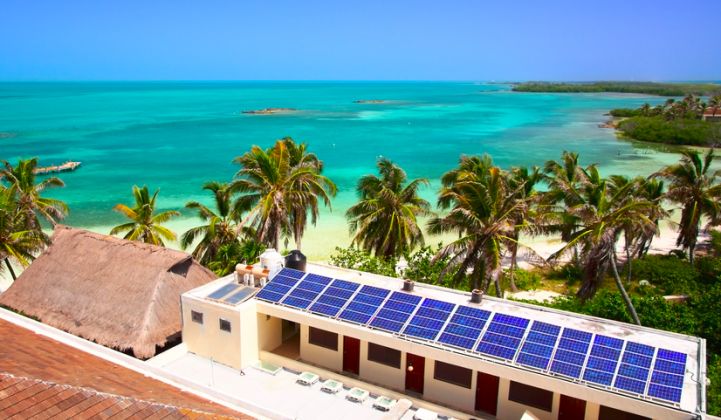Mexico’s wholesale power market launches this month as part of a comprehensive effort to reform the country's energy market. That reform also includes a new clean energy law, approved by the senate in December after a year of deliberations and modifications.
The law, outlining the minimum percentages for renewable energy generation over the next 35 years, is part of a raft of recent measures aimed at unleashing investment in cleaner sources of energy.
The legislation stipulates that Mexico must generate 25 percent of its power from clean sources by 2018, 30 percent by 2021, 35 percent by 2024, 45 percent by 2036, and 60 percent by 2050.
Mexico currently generates around 12 percent of its power from renewable sources.
Terminology changes were among the modifications made by lawmakers. The phrase "renewable energy" was changed to "clean energy," which will allow utilities to procure more natural gas as the country moves to replace oil-fired power stations, expand its pipeline network, and double generation capacity over the next 15 years.
The law also outlines the issuance of clean energy certificates (CECs), slated to begin from 2018, which will serve as both a green incentive and a regulatory mechanism to meet the country’s clean energy goals.
The modifications also allow companies without access to CECs in 2018 to defer 50 percent of their obligations for two years.
In December, the energy ministry (Sener) announced that the wholesale power market would officially launch on January 1. The national energy control center (Cenace), the watchdog created out of the energy reform, is fielding requests from companies seeking to participate in generation and infrastructure projects, either as standalones or in partnership with state-owned utility CFE.
Also in December, the energy regulatory commission (CRE) awarded the first permit for qualified electricity supply to local firm Energía Buenavista, which will sell electricity to qualified users as an intermediary between Cenace and end users.
"This is fundamental for fostering competition by freely serving large-scale and qualified consumers," CRE commissioner Marcelino Madrigal Martínez said at the time.
The first transmission tender is slated to take place in the first quarter of 2016, with 1,230 kilometers of lines connecting the Tehuantepec isthmus to the central part of the country. The Tehuantepec is where 97 percent of Mexico’s wind power capacity is located. Transmission and distribution infrastructure will remain the property of the state.
Mexico plans 24 transmission and distribution projects as part of the electric power system development program (Prodesen), aimed at modernizing and expanding the grid to meet growing demand. The country plans to add 25,000 kilometers of transmission lines over the next 15 years, with an investment of USD$13.4 billion.
Mexico’s first power auction for renewable generation projects is planned for March 31. Those projects will be anchored by 15-year contracts.
However, even with a wholesale framework taking shape, the growth of Mexico’s renewables sector may prove sluggish.
“Mexico’s solar market is playing out in a similar manner to those of other countries, but with the additional challenge that the fundamental paradigm of electricity is in transition,” said Mohit Anand, a senior analyst of global solar markets at GTM Research.
The changes to Mexico’s electricity market may be the biggest challenge for renewables developers.
“You have all the players for the game, but now the game has shifted and not everyone knows how to play," said Anand. "Any company that wants to be ready to go when the market is standing on a stronger footing needs to be in Mexico now and working through those rules and regulations and figuring out what they mean."
The 15 percent tariff levied on imported PV modules is an added obstacle for the solar industry. Mexico’s solar energy association (Asolmex) says the tariff increases project costs by around 40 percent. “Raising the cost [of PV modules] is a serious obstacle to investors being able to monetize their projects," Asolmex president Israel Hurtado told local press last October.
GTM Research's Anand was less sure about how much the tariffs would negatively impact developers or help domestic manufacturers.
“It’s a valid view, but tariffs on imported PV modules exist in all major markets, and I have my doubts as to how much tariffs impact local manufacturing,” Anand said. “Domestic manufacturing will take off when it’s ready, when manufacturers have long-term visibility of supply, and when capital is available to set up those plants."
Mexico is ranked 26 out of 50 on GTM Research’s PV manufacturing attractiveness index. With domestic demand strengthening, that ranking could improve, Anand said.
Mexico's wind industry is also dealing with its share of challenges. While wind power is gaining momentum in the country, projects are facing increasing opposition from local communities.
In Oaxaca state, where 21 wind farms produce around 1,800 megawatts of power, locals have successfully delayed the 396-megawatt Eólica del Sur project -- even with the government stepping in to help broker the deal.



